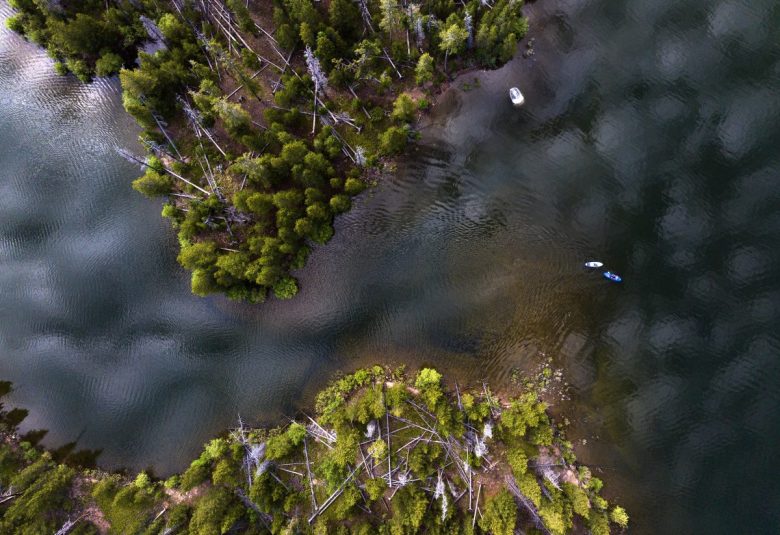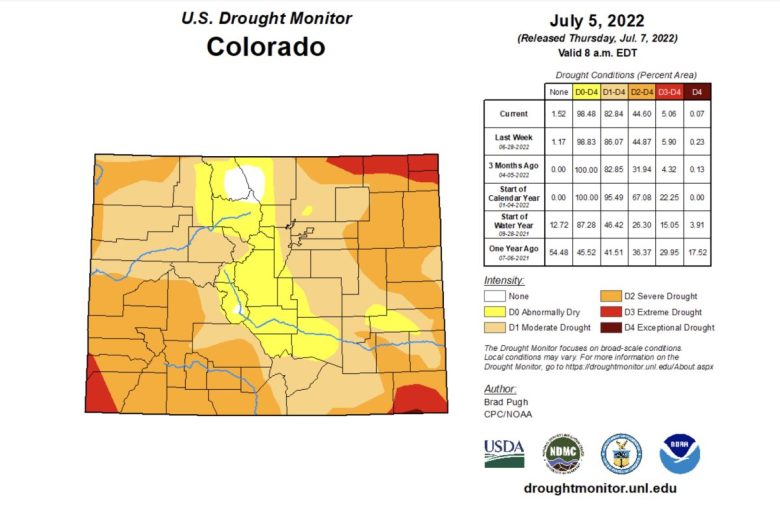Colorado is drought-free for the first time in four years, a rare respite for a state in the midst of a mega-drought.
According to the researchers, hot and dry conditions in the southwestern United States since 2000 represent the driest period on record in the past 1,200 years. Colorado itself has only had brief periods of time in the past 22 years when drought conditions have completely disappeared throughout the state.
But this year, snow, rain and hail have soaked the state so well that some areas of Metro Denver are beating rainy Seattle for year-to-date rainfall. This week, for the first time since mid-July 2019, Colorado is completely drought-free, according to the US Drought Monitor.
It’s a big deal in terms of, we don’t have to worry about the impacts of drought right now, said Becky Bolinger, Colorado’s assistant state climatologist. It is very rare for us to be in the summer months and have no drought anywhere in the state.
Drought Monitors’ map of Colorado typically displays bands of yellow, orange, and red across the state, indicating the location and severity of drought and near-drought conditions across the state.
The Drought Monitor compiles environmental indicators such as rainfall, flow rate, reservoir levels, temperatures and soil moisture into maps and data used by federal, state, local, tribal and regional decision makers. It is the leading source of drought information nationwide, Bolinger said.
As of Thursday, the Colorado drought map is all but clear.


Overall, what we’re seeing is that the wet pattern that we’ve been in, the excellent snowpack that we’ve helped make us completely drought free now, Bolinger said.
Not only did the state end the winter with above-average snow, but parts of Colorado received near-record rainfall.
For Denver, May was the fourth wettest May on record with about 5.53 inches of rain, according to National Weather Service data compiled by the Denver Museum of Nature and Science. In fact, Denver International Airport, where Denver’s official weather measurements are recorded, has reported more precipitation than Seattle-Tacoma International Airport since Jan. 1. Denver saw about 15.2 inches compared to Seattle’s 14 inches. (That’s about 6 inches off Seattle’s normal year-to-date precipitation, according to the Weather Service.)
Some areas around Castle Rock in Douglas County received 30 inches of precipitation. The area typically receives 15 to 20 inches of precipitation for the entire year, Bolinger said.
Western Colorado lags behind normal precipitation, based on historical data from 1991 to 2020. It has so far received 50 percent to 75 percent of its 30-year normal for April through June, according to National Weather Service meteorologist Lucas Boyer.
Southeastern Colorado, the only region with below-average snow cover this year, saw enough moisture and cooler temperatures to make up for the lack of snow, Bolinger said.
However, Bolinger said statewide rainfall in June appeared to be about 1.5 inches above average. Beginning in May, much of eastern Colorado was experiencing above-average rainfall.
A look back at the state’s drought over the past 22 years, however, shows how consistently these lulls are followed by more severe drought conditions, according to Drought Monitor data.

There were brief periods of time of mostly a few weeks or less when most of the state was completely or nearly drought free in 2000, 2001, 2009, 2015, and 2019.
But from those periods, in most cases, completely opposite conditions followed. Most of the state, 80% to 100%, was in or near drought conditions, including one exceptionally severe drought, from early 2002 to late 2004, mid-2012 to mid-2013, and mid-2013. 2020 to mid-2021, according to Drought Monitor data.
For most of the 22-year drought period, about 20% to 60% of the state experienced drought or near-drought conditions.
Isn’t this something that will last forever, and do we keep our eyes peeled for where the next drought development will be? Because it’s not a question of if, but when, Bolinger said.
The break from drought this year means that crops are benefiting from good snow and rain. In some cases, crops are delayed because they haven’t had enough sun and warmth. Hail, however, has been a problem, especially the smaller, wind-driven hail that damages every stalk of wheat, corn and alfalfa it hits, Bolinger said.
Throughout the Front Range, most municipalities draw less water for irrigation because residents rely on rain, rather than sprinklers, for their lawns and landscaping.

While there are wildfires across the state, they are easier to contain and control due to wetter conditions than devastating fires in dry years, he said.
When the winter snowpack melts, dry soils can absorb the runoff before it reaches streams and rivers. This year, soil moisture is in good shape across the state, Bolinger said.
If the soils are still in good shape in the fall, it will be a better start to the upcoming snow season and can help recharge deeper aquifers, he said.
And the reservoirs, the state’s water storage system, are recovering. For the past three years, winters have brought below-average snowfall to Colorado’s mountaintops, which has a drip effect on the entire Colorado River system, which spans seven Southwestern states and part of Mexico. That means shallower rivers, drier soils and shallower reservoirs, Bolinger said.
This year, Colorado’s reservoirs are filling up quickly. Blue Mesa, the state’s largest reservoir, went from a near-record low last summer to nearly capacity this summer. Dillon Reservoir, which feeds Denver’s water supply, was at 101 percent of its capacity Thursday.
The difference between what we’ve experienced, especially if you look at a year like 2020 or 2021, is the difference between night and day, Bolinger said. The conditions that were currently being experienced are completely opposite.
#Colorado #droughtfree #time
Image Source : coloradosun.com

